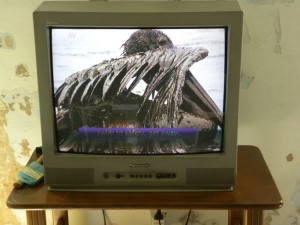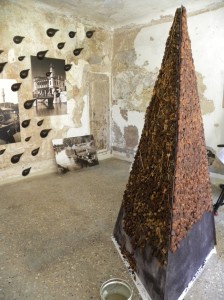

I found the Iraqi pavilion at the Venice Biennale, which was located outside the Giardini and Arsenal area, to be riveting. BBC’s prestigious director Alan Yentob, a BBC filmmaker, is making a major documentary about it. Yentob is Jewish Iraqi, growing up in the UK where he came in 1948, a year in which the Iraqi Jewish community was decimated by recruitment to Israel and the founding of the state of Israel that disrupted a formerly peaceful multi cultural relationship between religions in Iraq.
His documentary on BBC, unfortunately not available online, is brilliant and thorough, interviewing each of the artists at length. I have a copy which I hope I will be able to post in some way.
Located in the decayed Gervasuti Foundation building, the Iraqi exhibition had the theme of “Wounded Water.” The theme is both absolutely pertinent to Iraq and a resonant reference point for the works in the exhibition. Each of the artists approached it entirely differently, but together they reinforce the main message, the ongoing disaster that is contemporary Iraq with a particular theme of the difficulty of finding clean water.
The installation in a crumbling building underscores the condition of the infrastructure in Iraq, the theme of water focuses on the most urgent problem facing everyone in the country. In Ali Assaf’s video Narcissus a man leans over a slow moving stream. The lighting is Caravaggesque, from above. Gradually detritus appears floating down the river, a box, a document, photograph, scraps, until the water is barely visible. It is a quiet slow moving piece.
The artist is from Basra a place that used to be a beautiful city. When he returned he found it in ruins, its river polluted. Assaf also has an installation work dedicated to Basra that included, when I saw it an unfinished pyramid of dates ( some contaminated with depleted uranium from the first gulf war of 1991) , family photographs from long ago, splashes of oil on the wall, and a video with a series of stills of birds caught in the Gulf Oil Spill accompanied by a childhood song about the river and birds that the artist sings in Arabic with subtitles. The intersections of oil, pollution, environmental disaster, family, nostalgia, made this one of the most compelling installations in the pavilion.

Ali Assaf, detail of al Basra with video of oil soaked birds of Gulf Oil Spill accompanied by children’s song

In Azad Nanakeli’s Destnuej (Purification) has two adjoining images, a man is pouring water over himself as at a hamam on the left and gradually being engulfed by blood and then oil on the right.
Nanakeli also made a second resonant work called Au, Water. It is an installation with three oversize traditional water spiggots, and underneath a sea of plastic bottles. Dimly lighted, the water bottles at first look like a crystalline structure, then are revealled for the rubbish they are.
By far the most amusing in a deadly way is Adel Adibin Consumption of Water, a two room installation, one sparsely furnished with a filing cabinet and a chair, and a video of the sky, the second with a video of two business men who enter into a duel to the death using long neon lights as swords.
Walid Siti’s Beauty Spot animates the waterfall that is illustrated on an Iraqi bill, a waterfall that no longer exists since Turkey built a dam north of Iraq on the Tigris river and cut off the water. He also had a stunning installation of the dried up Great Zab river, a tributary of the Tigris, made with red mylar, that filled the entrance hall at the beginning of the exhibition.
The painter Ahmed Alsoundani, appears in several other exhibitions at the Biennale. His turbulent compositions cascade on the surface of the canves, revealing horrible scenes of carnage, death and destruction. Here is an interview with him about the pavilion and his work
Alsoudani’s statement was intriguing. He went to graduate school at Yale and it was clear that he had been told that he had to be “universal” and not too personal. His statement reiterated this art school language, even as his art is wrenchingly specific once you look at it closely. Although he does make reference to other art work, such as holocaust photographs and Goya, it is also strikingly original with almost the all over surface quality of a carpet. It depicts an Iraqi holocaust without any equivocation. His art is not specific to the theme of the exhibition as were other artists, but it is certainly pertinent to the theme of disaster in Iraq.
This was a brilliant pavilion, with art grounded in extreme anguish. It addresses one aspect of the environmental disaster of Iraq. For one part of the human disaster see my previous post on the monument to murdered Iraqi academics by Dia al Azzawi.
For more commentary on the Iraqi pavilion see the very complete coverage here.